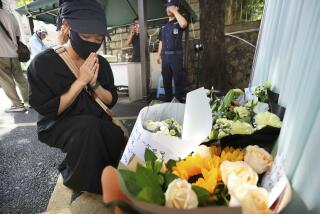Killings by Shiite Militias Detailed
Iraq’s two most deadly Shiite Muslim militias have killed thousands of Sunni Arabs since February, with the more experienced Badr Brigade often working in tandem with Al Mahdi army, collecting intelligence on targets and forming hit lists that Al Mahdi militia members carry out, a senior U.S. military official said Wednesday.
In some cases, death squads have been accompanied by a “clerical figure to basically run” an Islamic court to provide “the blessing for the conduct of the execution,” the official said.
The disclosures came during a U.S. intelligence briefing that included details about Shiite militia death squad operations and links to Iranian finance and weapons networks.
The military official said there were corrupt Iraqi security officers who allowed Shiite militia members to kill Sunni Arabs in Baghdad neighborhoods that had been secured by joint U.S.-Iraqi military sweeps aimed at quelling sectarian violence.
The official spoke on condition of anonymity, but was one of a series of high-ranking American officials who gave detailed briefings to reporters this week, at a time when the U.S. military is struggling to restore order to Baghdad and to press the Iraqi government to move decisively against Shiite militias.
The Badr Brigade, the military wing of the Supreme Council for Islamic Revolution in Iraq -- a member of the leading Shiite political bloc with 30 seats in parliament -- was responsible for most of the Shiite death squad killings last year, the official said.
That changed in February, when Sunni Arab insurgents bombed the Shiite shrine of the Golden Mosque in Samarra, and Al Mahdi army, a militia loyal to radical anti-Western Shiite cleric Muqtada Sadr, moved to the front of a rising sectarian bloodbath.
Sadr’s political organization also holds 30 parliamentary seats and controls several government ministries.
The hallmarks of the Shiite death squads have been mass killings in which the victims are found with their “hands bound, shot in the back or head,” and their bodies showing signs of torture, the U.S. official said.
Mosques and safehouses in Sadr City, a huge poor Shiite neighborhood that is the Al Mahdi stronghold in Baghdad, have been the base for many death squad operations, the official said.
The official also said that Iraq’s Interior Ministry, known to be heavily infiltrated by both Shiite militias, was complicit in many of the killings.
Militia members have used Iraqi security forces’ uniforms and vehicles during assassinations and checkpoint sweeps.
“Those would get up to 60 individuals detained in a sweep,” the official said. “OK, and again, often they would release those who were Shiite. We’d see that over the course of, say, that afternoon. And then there’d be individuals ransomed, and then there would perhaps be a mass killing in Sadr City and burial.”
American military officials have arrested at least 30 death squad members, the official said, all of them associated with extreme Al Mahdi militia elements.
Death squad cells within the Badr Brigade still carry out killings, the official said, but the number of slayings by Al Mahdi extremist cells has far outstripped them.
Al Mahdi militia’s growth has hindered Sadr’s ability to control the paramilitary force, the official said, citing instances when the cleric’s commands to fighters to stand down were ignored by militia commanders.
The official said U.S. investigators in Iraq have evidence that militiamen have acquired shoulder-fired rockets capable of shooting down aircraft, as well as Iranian-made explosives capable of puncturing armor plating.
Iran has “enhanced violence” in some militia-dominated Iraqi cities with its flow of weapons, the official said, but he downplayed the Shiite-controlled country’s long-term influence in Iraq, saying that Iraq’s historic independent streak would eventually outweigh its affinities for its neighbor.
*
More to Read
Sign up for Essential California
The most important California stories and recommendations in your inbox every morning.
You may occasionally receive promotional content from the Los Angeles Times.










